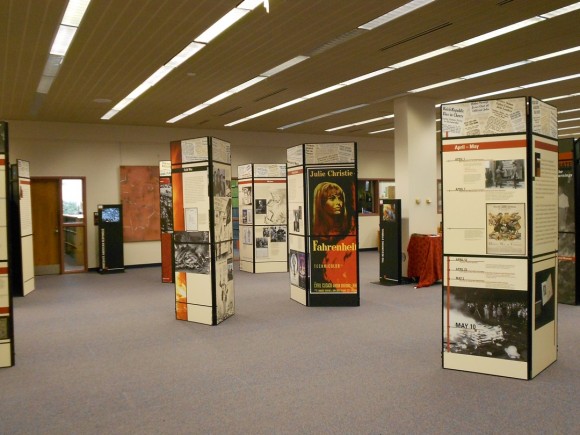Martin Steele/Catalyst
The exhibit takes up 1,200 square feet of floor space and features audio/visual touch-screen panels as well as large panels emblazoned with eye-catching pictures and informative text.
“For Americans, the iconography of Nazism is found in the swastika, the jackboot, the Nazi banner,” the opening text of an informational pamphlet reads. “But another symbol — flames and fire — accompanied the Third Reich from its strident inception to its apocalyptic demise.”
The pamphlet is one of the many informative elements of the museum exhibit occupying the corner of the Jane Bancroft Cook Library, titled Fighting the Fires of Hate: America and the Nazi Book Burnings. The topic of discussion is the events and fallout of May 10, 1933, in which right-wing students across Germany “burned upwards of 25,000 volumes of ‘un-German’ books, presaging an era of state censorship and control culture.” In addition to the pamphlets, 23 panels and four touch-screen kiosks have been available for public viewing since Feb. 8, and will continue to be until March 30.
The exhibit is currently traveling on loan from the U.S. Holocaust Memorial Museum, whose Chief of Staff, William S. Parsons, was present for the exhibit’s opening on the 8th. Its presence in the library has been planned since a year ago and was largely made possible by the efforts of the New College Library Association and Dr. Helen Fagin, whose name graces the library’s extensive Holocaust collection. According to library Dean Brian Doherty, this is the first time the library has hosted an external exhibit of this nature, and is being used as a “test case to see whether it works.
“It appears so far it’s working well,” Doherty told the Catalyst. He said it helps present the library and its resources as part of an interactive learning experience, making it seem “less a repository of books” and more “a place to learn.” He also noted that, compared to the collection of Holocaust books, the eye-catching displays seem particularly e
ffective at drawing in the casual viewer. “When it’s on display, it’s brought to life,” he said. “It’s in your face … it’s right there in front of you.”

photo courtesy of ushmm.org
This striking image of a book burning in Opera Square, Berlin on May 10, 1933 is one of many on display at the exhibit. Many authors, German and non-German, as well as those who were Jewish, leftist, pacifist, Communist, or otherwise offensive to Nazi ideals, were targeted, including Sigmund Freud, Albert Einstein, Karl Marx, H.G. Wells, Upton Sinclair and Jack London.
Hosting the exhibit in itself was free of charge, though the library was responsible for the cost of shipping it to Sarasota — the funds for this were acquired from outside donors. According to Doherty, the most difficult aspect of bringing in the exhibit were clearing the floor space in advance, bringing the individual pieces in and setting them up. “The people from Physical Plant were extremely helpful,” he said.
Though the library did not have the resources for paid outside advertising, the staff have attempted to generate large amounts of publicity among the New College population, and have raised some awareness in the surrounding community with flyers, complimentary ads and word-of-mouth. Doherty stressed the importance of earning such wide-range exposure for the library, especially now, since it is in the midst of a fundraising campaign. He also indicated, however, that the exhibit is not meant to draw standard museum-sized crowds, given the desire to “maintain our library ambience” for students.
The exhibit will be gone by the end of March, but the space could potentially be used for similar purposes in the future, depending on the overall success of this one. Asked for ideas, Doherty suggested that the space could be used for something from within the New College community, such as a formal exhibition by a student club. “That’s something we’d be very interested in,” he said.
The Fighting the Fires of Hate exhibit will be open to all members of the public during library hours until March 30. Photos are permitted, though visitors are advised not to disturb patrons studying nearby.

